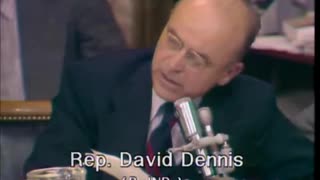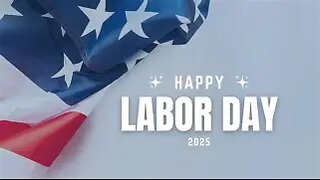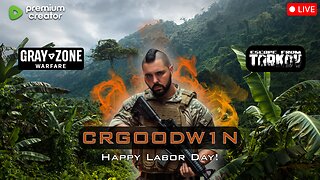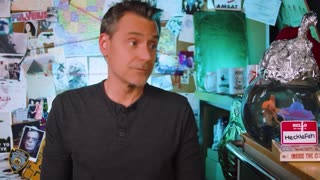Premium Only Content

Scandals Unveiled: Investigations into Cocaine, Sex Rings, and Corruption in Government
Barry Goldwater Jr. cocaine investigation refers to the investigation that took place in the early 1980s, where the son of the former Republican Senator from Arizona, Barry Goldwater Jr., was allegedly involved in a cocaine scandal. The investigation, which lasted for several months, was conducted by the Drug Enforcement Administration (DEA) and the Federal Bureau of Investigation (FBI).
The scandal broke out after a confidential informant claimed that Goldwater Jr. had purchased cocaine from him on several occasions. Goldwater Jr. was serving as a U.S. Representative from California at the time. The investigation eventually led to the indictment of Goldwater Jr. on charges of cocaine possession.
The investigation received significant media attention, as it involved a prominent political figure and brought to light the issue of drug use among politicians. The case was closely watched by the public and the media, with many speculating about the potential impact it could have on Goldwater Jr.'s political career and his family's reputation. Ultimately, Goldwater Jr. pleaded guilty to the charges and was sentenced to probation and community service.
The murder trial of Eddie James Carthan was a high-profile legal case that took place in the early 1980s in Mississippi, United States. Carthan, a former mayor of Tchula, Mississippi, was accused of being involved in the murder of a local white businessman named Gus Cothran.
The case was controversial because it was believed by some to be racially motivated. Carthan, who was African American, had been an activist for civil rights and had previously clashed with Cothran over issues related to racial discrimination.
During the trial, the prosecution presented evidence that Carthan had conspired with two other men to murder Cothran. The defense argued that the evidence was circumstantial and that Carthan had been framed. The trial lasted for several weeks and attracted significant media attention.
In the end, Carthan was found guilty of murder and sentenced to life in prison. The case sparked widespread debate about race relations in Mississippi and the criminal justice system's treatment of African Americans.
Charles Bowsher was the U.S. Comptroller General from 1981 to 1996. During his tenure, he became embroiled in a travel scandal that involved using government funds for personal travel expenses.
The scandal began in 1994 when it was revealed that Bowsher had used taxpayer funds to pay for first-class airline tickets, luxury hotel accommodations, and limousine services during his official travel. He also allegedly used government funds to pay for his wife's travel expenses on multiple occasions.
In response to the scandal, Bowsher defended his actions by claiming that he was entitled to such lavish travel accommodations due to the nature of his job as Comptroller General. However, his actions were widely criticized by lawmakers and the public, who viewed his travel expenses as excessive and unjustifiable.
The scandal eventually led to a congressional investigation and a report that was critical of Bowsher's use of government funds. Bowsher retired from his position as Comptroller General in 1996, but the scandal tarnished his reputation and led to increased scrutiny of government officials' travel expenses.
Barry Morris Goldwater Jr. (born July 15, 1938) is an American businessman and politician. He is a former Republican member of the United States House of Representatives from California, serving from 1969 to 1983. He is the son of U.S. Senator and 1964 Republican presidential nominee Barry Goldwater.
Early life
Goldwater was born in Los Angeles, California, on July 15, 1938, the son of Barry M. Goldwater and his wife Margaret Johnson. He graduated from Staunton Military Academy in Staunton, Virginia, in 1957. Goldwater attended the University of Colorado, and graduated from Arizona State University in 1962. He then worked as a stockbroker, public relations executive, and in import-export business, before being elected to Congress.
In 1972, he married Susan Lee Gherman, daughter of Dr. E. Mortimer and Irene Gherman of Newport Beach, California. They had a son, Barry M. Goldwater, III. The couple divorced in May 1979.
Political career
In office
Goldwater during his tenure in Congress
When Edwin Reinecke resigned from Congress in January 1969 to become lieutenant governor of California, this opened up California's 27th district which at the time covered parts of northern Los Angeles County. In the following special election, Goldwater was selected as the Republican nominee, and John Van de Kamp was selected by the Democrats. Goldwater won 57% to 43%, serving for the remainder of the 91st Congress, and was reelected twice. He was redistricted to the 20th district ahead of the 1974 election, and was elected to another four terms in that district.
During his time in Washington, Goldwater served on several committees, such as the Committee on Public Works and Transportation, the Joint Committee on Energy, and the Committee on Science and Technology. He drafted a number of bills while serving in the House, most notably the Privacy Act of 1974, which prevents the distribution of private information from government and businesses.
Goldwater speaking during the launch of USS Reid (FFG-30) in 1981
With his district merged with that of Bobbi Fiedler due to redistricting, Goldwater retired from the House to run for the Republican nomination to the Senate in 1982. He lost that race to San Diego mayor and future Governor Pete Wilson, who would go on to win the general election. Goldwater attributed his loss to what he called "partisan mudslinging" which linked his name to a congressional drug-use scandal, though Goldwater was ultimately found to be uninvolved. During that time, Goldwater did seek help from a treatment center in Wickenburg, Arizona, for an admitted drinking problem.[citation needed]
Advocacy
In the 1980 presidential election, Goldwater campaigned for Ronald Reagan, a family friend, who won the election against Jimmy Carter. Ahead of the 2003 recall election to replace Gray Davis as Governor of California, he supported Arnold Schwarzenegger, and had a public debate with President Reagan's son Ron Reagan.[citation needed]
On November 16, 2007, Goldwater endorsed Republican presidential candidate Ron Paul of Texas for the GOP nomination in 2008.[1] On January 5, 2008, Goldwater announced his decision to go to New Hampshire to campaign for Ron Paul,[2] after Paul's 10% showing in the Iowa caucuses, held on January 3, 2008. Paul would garner 8% of the vote in New Hampshire. He also spoke in support of Ron Paul at the Kansas GOP caucus.
On September 4, 2008, a list of electors in Louisiana using the label "Louisiana Taxpayers Party" paid $500 and filed papers[3] with the Secretary of State's Office[3] to get on the ballot. They were pledged to Ron Paul for president, and to Goldwater for vice president.[3] The ticket received 9,368 votes in Louisiana, coming in third place in the popular vote.[4]
In 2015, Goldwater was chairman of TUSK – Tell Utilities Solar won't be Killed – "that aims at pushing solar from a different perspective: a Republican one".[5] The group favored net metering. In the same policy area, the Goldwater Institute "sued to have [Arizona]'s renewable energy standards and tariffs throw[n] out in a move that would have slowed solar development to a crawl", per Phoenix Business Journal.[6]
Business career
Goldwater in 2017
After retiring from politics, Goldwater moved to Los Angeles and pursued a career in the financial sector, specializing in security law and underwriting. His clients were major U.S. banks and insurance companies. Goldwater became a member of the New York Stock Exchange, and a partner in what is now Wedbush Securities (formerly Noble Cook, Inc.)
Goldwater lives in Phoenix, Arizona, near his son Barry M. Goldwater III.
He has served on the board of the Barry M. Goldwater Scholarship and Excellence in Education Program. As of October 2018, he serves on the board of directors of the Goldwater Institute. The Goldwater Institute is a non-profit political think tank which studies and publishes findings on public policies that align with the conservative values promoted by Goldwater's father. Goldwater generally supported legislation and policies that embrace economic independence, individual rights, and limited government.[citation needed]
Goldwater maintains his contact with Republican and Democratic leaders, as well as celebrity activists, and is still active in the conservative political movement. He is a member of the American Numismatic Association, and is currently director of the National Collector's Mint.[citation needed]
Awards and honors
Goldwater has won several awards, including the Achievement Award from the National Academy of Television Arts & Sciences, an award from the President's Commission on Employment of the Handicapped, the Distinguished Service Award of the A.C.A., and the Conscience of the Congress Award of the American Conservative Union.[citation needed]
References
flagArizona portalflagCalifornia portaliconPolitics portalConservatism portal
Ron Paul Endorsed by Barry Goldwater, Jr. – Ron Paul 2008
Barry Goldwater, Jr., to Campaign for Ron Paul in NH – Ron Paul 2008
Winger, Richard. Louisiana Asked to Print Ron Paul on Ballot as Presidential Candidate. Ballot Access News, 4 September 2008. Retrieved 2008-09-08. "On September 4, a slate of presidential electors was filed at the Louisiana Secretary of State's office, in person. The electors are pledged to Ron Paul for president, and former Congressman Barry Goldwater, Jr., for vice-president. The partisan label for this slate is "Louisiana Taxpayers Party." The filing, and the ,00 was accepted* * *"
"United States Presidential Election Results, 2008, Louisiana,", Dave Leip's Atlas of U.S. Presidential Elections. Retrieved February 4, 2009.
TUSK webpage, dontkillsolar.com. Retrieved 14 June 2015.
O'Grady, Patrick, "Arizona solar battle heating up between installers, APS", Phoenix Business Journal, March 29, 2013. Retrieved 14 June 2015.
External links
Barry Goldwater Jr. official website
Congressional biography
Appearances on C-SPAN
HBO Interview in Mr. Conservative
Goldwater Institute
Barry M. Goldwater Scholarship and Excellence in Education Program
U.S. House of Representatives
Preceded by
Edwin Reinecke
Member of the U.S. House of Representatives
from California's 27th congressional district
1969–1975 Succeeded by
Alphonzo E. Bell Jr.
Preceded by
Carlos Moorhead
Member of the U.S. House of Representatives
from California's 20th congressional district
1975–1983 Succeeded by
Bill Thomas
U.S. order of precedence (ceremonial)
Preceded by
Dave Loebsack
as former U.S. Representative Order of precedence of the United States
as former U.S. Representative Succeeded by
Gary Condit
as former U.S. Representative
vte
Barry Goldwater
Political career
Electoral history of Barry Goldwater Alaska Mental Health Enabling Act Goldwater v. Carter Cable Communications Policy Act of 1984 Goldwater–Nichols Act
Elections
1952 1958 1964 presidential campaign 1964 Republican National Convention 1964 United States presidential election 1968 1974 1980
Family
Barry Goldwater Jr. (son)
Other
Barry Goldwater statue The Conscience of a Conservative The Goldwaters (musical group) Goldwater v. Ginzburg Goldwater rule Barry M. Goldwater Scholarship Barry M. Goldwater Air Force Range Goldwater Institute
Category Commons
Authority control Edit this at Wikidata
International
FAST ISNI VIAF WorldCat
National
France BnF data Germany Israel Belgium United States
People
US Congress
Other
NARA IdRef
Categories:
1938 birthsLiving peopleAmerican people of English-Jewish descentAmerican people of Polish-Jewish descentAmerican stockbrokersArizona RepublicansArizona State University alumniBarry GoldwaterJewish members of the United States House of RepresentativesPoliticians from Los AngelesPoliticians from Phoenix, ArizonaRepublican Party members of the United States House of Representatives from CaliforniaStaunton Military Academy alumniUniversity of Colorado Boulder alumni
https://en.wikipedia.org/wiki/Barry_Goldwater_Jr.
Cocaine is the second most popular illegal recreational drug in the United States behind cannabis,[1] and the U.S. is the world's largest consumer of cocaine.[2] In 2020, Oregon became the first U.S. state to decriminalize cocaine.[3]
Before 1950s
Calls for prohibition began long before the Harrison Narcotics Tax Act was passed by Congress in 1914 – a law requiring cocaine and narcotics to be dispensed only with a doctor's order.[4] Before this, various factors and groups acted (primarily at the state level) on influencing a move towards prohibition and away from a laissez-faire attitude.[5] Cocaine consumption had grown in 1903 to about five times that of 1890, predominately by non-medical users outside the middle-aged, American, professional class. Cocaine became associated with laborers, youths, black people, and the urban underworld.[6]
Popularization of cocaine is first evident with laborers who used it as a stimulant,[6] often supplied by employers who falsely believed that it increased productivity.[7] African American workers were believed by employers to be better at physical work and it was thought that it provided added strength to their constitution which, according to the Medical News, made black people "impervious to the extremes of heat and cold".[6] Instead, cocaine use quickly acquired a reputation as dangerous and in 1897, the first state bill of control for cocaine sales came from a mining county in Colorado.[8] Laborers from other races used cocaine, such as in northern cities, where cocaine was often cheaper than alcohol.[7] In the Northeast in particular, cocaine became popular amongst workers in factories, textile mills, and on railroads.[9] In some instances, cocaine use supplemented or replaced caffeine as the drug of choice to keep workers awake and working overtime.[9]
Fears of coerced cocaine use, and in particular that young girls would become addicted and thereby enter prostitution, were widespread.[10][11] Tales of the corruption of the youth by cocaine were common but there is little evidence to support their veracity.[10] Mainstream media reported cocaine epidemics as early as 1894 in Dallas, Texas. Reports of the cocaine epidemic would foreshadow a familiar theme in later so-called epidemics, namely that cocaine presented a social threat more dangerous than simple health effects and had insidious results when used by blacks and members of the lower class. Similar anxiety-ridden reports appeared throughout cities in the South, leading some to declare that "the cocaine habit has assumed the proportions of an epidemic among the colored people". In 1900, state legislatures in Alabama, Georgia, and Tennessee considered anti-cocaine bills for the first time.[12]
Hyperbolic reports of the effect of cocaine on African Americans went hand-in-hand with this hysteria. In 1901, the Atlanta Constitution reported that "Use of the drug [cocaine] among negroes is growing to an alarming extent".[13] The New York Times reported that under the influence of cocaine, "sexual desires are increased and perverted...peaceful negroes become quarrelsome, and timid negroes develop a degree of 'Dutch courage' that is sometimes almost incredible".[14] A medical doctor even wrote “cocaine is often the direct incentive to the crime of rape by the negroes.”[14] To complete the characterization, a judge in Mississippi declared that supplying a “negro” with cocaine was more dangerous than injecting a dog with rabies.[15]
These attitudes not only influenced drug law and policy but also led to increased violence against African Americans. In 1906, a major race riot led by whites erupted; it was sparked by reports of crimes committed by black "cocaine fiends".[13] Indeed, white-led race riots spawning from reports of black people under the influence of cocaine were not uncommon.[16] Police in the South widely adopted the use of heavier caliber handguns so as to better stop a cocaine-crazed black person – believed to be empowered with superhuman strength.[17] Another dangerous myth perpetuated amongst police was that cocaine imbued African Americans with tremendous accuracy with firearms and therefore police were better advised to shoot first in questionable circumstances.[18] Ultimately public opinion rested against the cocaine user. Criminality was commonly believed to be a natural result of cocaine use.[19] Much of the influence for these kind of perceptions came from the widespread publicity given to notorious cases.[5] While the historical reality of cocaine's effect on violence and crime is difficult to disentangle from inflamed perceptions, it does appear that public opinion was swayed by the image of the violent, cocaine-crazed fiend and pushed over the edge by a few violent episodes.[19] It was an image of the cocaine-user that carried acute racial overtones.[5]
Before any substantive federal regulation of cocaine, state and local municipalities evoked their own means to regulate cocaine. Because of the initial lack of targeted legislation, on both federal and state level, the most typical strategy by law enforcement was the application of nuisance laws pertaining to vagrancy and disturbing the peace.[20] Subsequent legislative actions aimed at controlling the distribution of cocaine rather than its manufacture.[21] Reformers took this approach in part because of legal precedents which made it easier to control distributors such as pharmacies; state and local boards of health or boards of pharmacy often took the place of regulatory bodies for controlling the distribution of cocaine.[21] Some states took the position of outright banning of all forms of cocaine sale; Georgia was the first to do this in 1902.[22] A New Orleans ordinance banned cocaine sales as well but left an ill-defined exception for therapeutic uses.[21] A more common requirement was to restrict the sale of cocaine or impose labeling requirements. A 1907 California law limiting sale of cocaine to only those with a physician's prescription resulted in the arrest of over 50 store owners and clerks in the first year.[21] A 1913 New York state law limited druggists’ cocaine stocks to under 5 ounces. Labeling requirements initially operated on a state level with some states even going so far as to require that cocaine and cocaine-containing products be labeled as poison.[23]
Eventually the federal government stepped in and instituted a national labeling requirement for cocaine and cocaine-containing products through the Food and Drug Act of 1906.[23] The next important federal regulation was the Harrison Narcotics Tax Act of 1914. While this act is often seen as the start of prohibition, the act itself was not actually a prohibition on cocaine, but instead set up a regulatory and licensing regime.[4] The Harrison Act did not recognize addiction as a treatable condition and therefore the therapeutic use of cocaine, heroin, or morphine to such individuals was outlawed – leading the Journal of American Medicine to remark that an addict "is denied the medical care he urgently needs, open, above-board sources from which he formerly obtained his drug supply are closed to him, and he is driven to the underworld where he can get his drug, but of course, surreptitiously and in violation of the law".[24] The Harrison Act left manufacturers of cocaine untouched so long as they met certain purity and labeling standards.[25] Despite that cocaine was typically illegal to sell and legal outlets were more rare, the quantities of legal cocaine produced declined very little.[25] Legal cocaine quantities did not decrease until the Jones-Miller Act of 1922 put serious restrictions on cocaine manufactures.[25]
1950s and 1960s
The popularity of cocaine faded in the 1950s, and by the late 1950s many considered the drug to be a problem of the past. Cocaine became popular in America again in the 1960s, undergoing a kind of reemergence.[26]
1970s and 1980s
See also: Cocaine boom
In the 1970s and 1980s, the drug became particularly popular in the disco culture as cocaine usage was very common and popular in many discos such as Studio 54, even spawning open publications such as Adam Gottlieb's 1976 book The Pleasures of Cocaine which appealed to the collective experience of prohibition to call for legalization:
The path of cocaine as it stands in the streets of and north America today offers dangers not only inherent in the pharmacology of the alkaloid itself, but also in the bizarre assortment of adulterants which are added to it by black market middlemen. This is what happens when a popular substance is made illegal. We have lived this nightmare before and still have not learned.
— Adam Gottlieb, The Pleasures of Cocaine, 1976.
The drug also became particularly popular in rock music culture. Songs such as Eric Clapton's 1977 release, "Cocaine," was written by J. J. Cale.
1990s
The National Household Survey on Drug Abuse (NHSDA) reported that in the United States in 1999 that cocaine was used by 3.7 million people, or 1.7% of the household population age 12 and older. Estimates of the current number of those who use cocaine regularly (at least once per month) vary, but 1.5 million is a widely accepted figure within the research community. In 2001, more Hispanics received sentences for crimes relating to powder cocaine than any other ethnicity while more African Americans were convicted of crimes relating to crack cocaine in the United States.
Although cocaine use had not significantly changed over the six years prior to 1999, the number of first-time users went up from 574,000 in 1991, to 934,000 in 1998 – an increase of 63%. While these numbers indicated that cocaine is still widely present in the United States, its use was significantly less prevalent than during the early 1980s.
Usage among youth
The 1999 Monitoring the Future (MTF) survey found the proportion of American students reporting use of powdered cocaine rose during the 1990s. In 1991, 2.3% of eighth-graders stated that they had used cocaine in their lifetime. This figure rose to 4.7% in 1999. For the older grades, increases began in 1992 and continued through the beginning of 1999. Between those years, lifetime use of cocaine went from 3.3% to 7.7% for tenth-graders and from 6.1% to 9.8% for high-school seniors. Lifetime use of crack cocaine, according to MTF, also increased among eighth-, tenth-, and twelfth-graders, from an average of 2% in 1991 to 3.9% in 1999.
Perceived risk and disapproval of cocaine and crack use both decreased during the 1990s at all three grade levels. The 1999 NHSDA found the highest rate of monthly cocaine use was for those aged 18–25 at 1.7%, an increase from 1.2% in 1997. Rates declined between 1996 and 1998 for ages 26–34, while rates slightly increased for the 12–17 and 35+ age groups. Studies also show people are using cocaine at younger ages. NHSDA found a steady decline in the mean age of first use from 23.6 years in 1992 to 20.6 years in 1998.
2020s
In 2020, the state of Oregon became the first U.S. state to decriminalize cocaine.[27][28] This new law prevents people with small amounts of cocaine from facing jail time. In 2020, the U.S. state of Oregon would also become the first state to decriminalize the use of heroin.[29] This measure will allow people with small amounts to avoid arrest.[30] The measure was adopted by referendum 3 November 2020, and introduced a Drug Addiction Treatment and Recovery Act,[31] effective 3 December 2020.[32] The Act[33] introduced changes to Oregon law (ORS), effective 1 February 2021,[34] including reclassification of most possession offences.[35] It also introduced measures for better treatment and recovery for drug addiction.[36]
See also
Crack epidemic
Prohibition of cocaine in the United States
DePierre v. United States
General:
List of countries by prevalence of cocaine use
Drugs in the United States
Crime in the United States
References
"erowid.org". Archived from the original on October 6, 2007. Retrieved 2007-07-10.
"Field Listing – Illicit drugs (by country)". Cia.gov. Archived from the original on 2010-12-29. Retrieved 2011-01-15.
Fuller, Thomas (4 November 2020). "Oregon Decriminalizes Small Amounts of Heroin and Cocaine; Four States Legalize Marijuana". The New York Times.
(Madge 2001, p. 106)
Spillane, p. 121
Spillane, p. 91
(Madge 2001, p. 84)
Spillane, pp. 92–93
Spillane, p. 93
(Gootenberg 1999, p. 33)
(Madge 2001, p. 102)
Spillane, p. 94
(Madge 2001, p. 85)
(Madge 2001, p. 89)
(Madge 2001, p. 88)
Spillane, p. 120
(Madge 2001, p. 90)
(Madge 2001, p. 91)
Spillane, p. 119
Spillane, p. 111
(Gootenberg 1999, p. 35)
(Madge 2001, p. 82)
(Gootenberg 1999, p. 37)
(Madge 2001, p. 107)
(Gootenberg 1999, p. 40)
Das, G (1993). "Cocaine abuse in North America: a milestone in history". Journal of Clinical Pharmacology. 33 (4): 296–310. doi:10.1002/j.1552-4604.1993.tb04661.x. PMID 8473543. S2CID 9120504.
"Oregon becomes first state to decriminalize hard drugs like heroin and cocaine". Fox News. 3 November 2020.
"Oregon becomes the first state to decriminalize hard drugs like cocaine and heroin". CBS News.
Cleve R. Wootson Jr.; Jaclyn Peiser (2020-11-04). "Oregon decriminalizes possession of hard drugs, as four other states legalize recreational marijuana". The Washington Post. Washington, D.C. ISSN 0190-8286. OCLC 1330888409.
"Oregon becomes first US state to decriminalize possession of hard drugs". TheGuardian.com. 4 November 2020.
Oregon Measure 110, Drug Decriminalization and Addiction Treatment Initiative (2020), Ballotpedia
Laws governing the initiative process in Oregon, Ballotpedia, cf. Oregon Constitution, Article IV, Section 1 (4d)
Drug Addiction Treatment and Recovery Act
Section 25 of the Act
Section 11 to 19 of the Act, including an option that a completed health assessment is used in lieu of a fine for certain violations (Section 19, changing ORS 153.018 (2) e
Drug Addiction Treatment and Recovery Act, Oregon Health Authority
Bibliography
Gootenberg P, ed. (1999). Cocaine: Global Histories. London: Routledge. ISBN 978-0-203-02646-5.
Madge T (2001). White Mischief: A Cultural History of Cocaine. Edinburgh: Mainstream Publishing Company. ISBN 978-1-84018-405-1.
Spillane JF, ed. (2000). Cocaine: From Medical Marvel to Modern Menace in the United States, 1884–1920. Baltimore and London: The Johns Hopkins University Press. ISBN 978-0-8018-6230-4.
Category:
Cocaine in the United States
-
 9:22:13
9:22:13
The Memory Hole
7 months agoNixon Impeachment Hearings Day 4 (1974-07-26)
1.07K -
 1:12:35
1:12:35
theoriginalmarkz
2 hours agoCoffee with MarkZ. 09/01/2025
33.4K9 -
 2:59:48
2:59:48
Wendy Bell Radio
8 hours agoSunday, Bloody Sunday
113K229 -
 1:10:02
1:10:02
crgoodw1n
2 hours agoHAPPY LABOR DAY! Tactical shoosting W/ @BenderOdoyle Ask about !12hr !freshenup !discord
7.67K2 -
 LIVE
LIVE
ENEMYOFDEATH2012
14 hours agoGod of War Playthrough Pt. 2 and some Fortnite
25 watching -
 4:47:50
4:47:50
The Why Files
2 days agoCOMPILATION: UFOs and Aliens Vol.2 | They are NOT our friends
92.2K53 -
 1:33:46
1:33:46
BubbaMatt
2 hours agoMafia Definitive Edition Playthrough - Part 1
3.13K -
 LIVE
LIVE
Jorba4
1 hour ago🔴Live-Jorba4- The Finals
11 watching -
 LIVE
LIVE
Lofi Girl
2 years agoSynthwave Radio 🌌 - beats to chill/game to
246 watching -
 LIVE
LIVE
FyrBorne
15 hours ago🔴Warzone M&K Sniping: Finding Season 5's Best Strafe ARs
68 watching